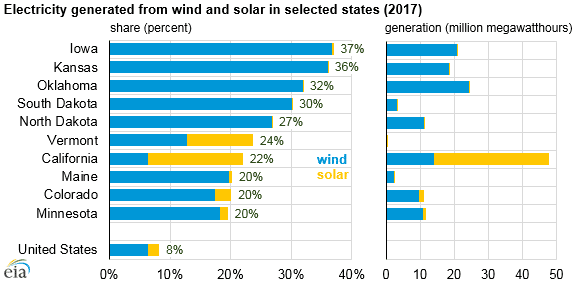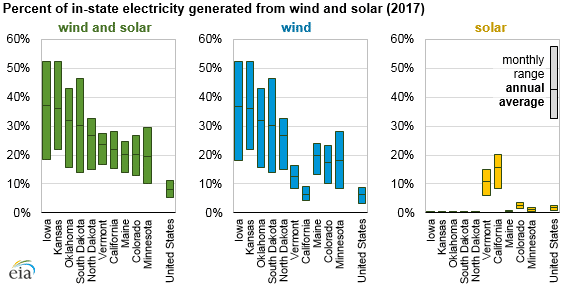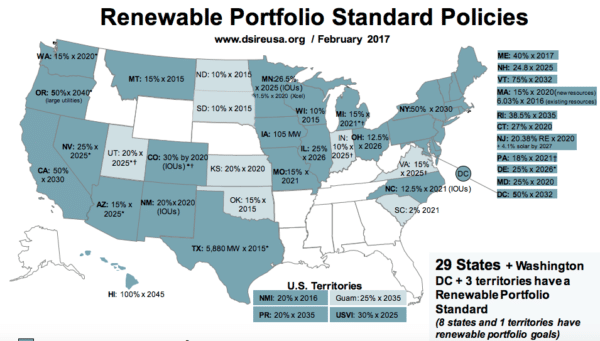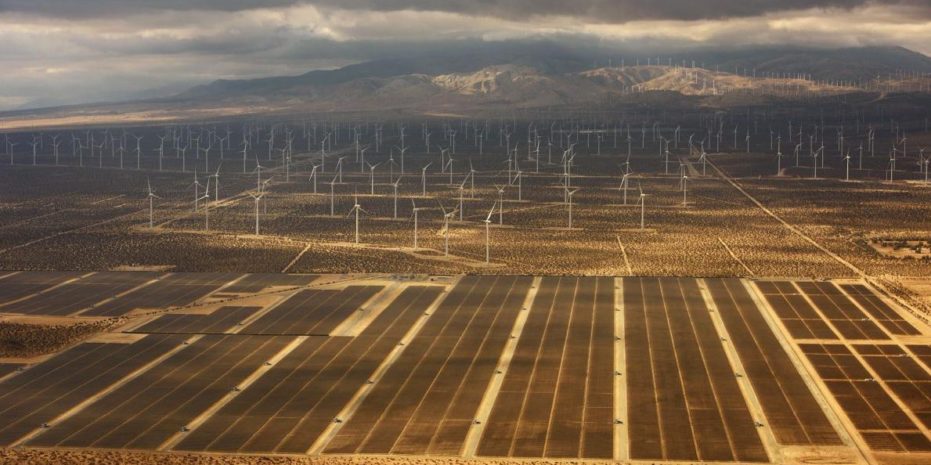The recent report from the Intergovernmental Panel on Climate Change (IPCC) has put in stark terms that we have 12 years to clean up our carbon emissions, or face dire consequences for our civilization and our species.
That’s the bad news. The good news is that an energy transition is underway in the electricity sector. When the U.S. Department of Energy’s Energy Information Administration (EIA) put out full-year electricity generation numbers for 2017, we at pv magazine crunched these numbers and reported that solar now represents more than 10% of in-state generation in five states.
Today EIA topped that with their own analysis which shows that combined wind and solar represented more than 20% of generation in ten states in 2017.

This is mostly wind and is led by Midwestern and Plains States, which have very strong wind resources, and on a monthly basis wind has represented more than 50% of generation in Iowa and Kansas. However in both Vermont (24% wind and solar) and California (22%) solar represents at least half of the annual total.

It is also notable that many of these states have small populations and limited electricity demand, which may explain why EIA found that wind and solar made up only 8% of the total electricity production in the United States in 2017 – although this number had already jumped to 9% in the first half of 2018.
The interesting thing about the states leading this transition is that they mostly don’t have renewable energy mandates. National leader Iowa (37% wind) was the first state to pass a renewable portfolio standard in 1986; however this policy never really advanced and requires only 105 MW of renewables, which was reached long ago.

Graphic: North Carolina Clean Energy Technology Center
Likewise Kansas, Oklahoma, South Dakota and North Dakota (#2-#5) have all blown through the voluntary renewable energy goals that were set at the state level for utilities.
However Vermont and California (#6,#7) are very different. These states have the some of the strongest goals for renewable and zero-carbon electricity in the United States, with California recently mandating 100% zero-carbon generation by 2045, and Vermont calling for 75% renewable energy by 2032 – a goal second only to Hawaii’s 100% by 2045 in its ambition.
As such, there are a number of other states that are likely to be joining the 20%+ club in the near future. These include not only Hawaii but Texas, which has already been getting a large portion of its electricity from wind, and is now undergoing a solar boom.
And while wind and solar are not the only resources allowed, they are likely to be most of the compliance with 50% by 2030 renewable energy mandates in New York and New Jersey, which means that these states are likely to pass the 20% mark within five years.
As such, between the market success of renewable energy in Texas, the Plains States and other regions and ambitious mandates in West Coast and Northeast states, the transition to wind and solar is likely to accelerate over the next decade, regardless of the policy actions of the Trump Administration.
This content is protected by copyright and may not be reused. If you want to cooperate with us and would like to reuse some of our content, please contact: editors@pv-magazine.com.









New Mexico also looks like they will blow into the 20% club since 1H2018 they are at 26% RE.
Looking at the EIA’s data through July 2018 it looks like Texas will hit the 20% club next year. They are at 18.1% for the first half of 2018. Their solar+wind increased 15.9% compared to first half 2017. If it just increases another 11% next year they will at 20%.
This would be really good since Texas is uses way more energy than any other state – by far.
Several states had nice double digit percentage RE growth compared to first half 2017.
I am not sure why it has taken this long for the US to gain momentum in making this transition but anyhow it is very welcome and as the article ended on a positive note, really hope that between here and 2030 we will see the nation as a whole achieve really high figures.
Trump is an absolute nut and his policies are simply reflecting the madness that lives in his head. I sincerely hope the US can get through this nightmare period as soon as possible and that all policies implemented by him will be relegated to history under padlock.
Note that this is only wind and solar. Clean safe renewable energy (RE) also includes hydro, geothermal, clothesline paradox energy, small amounts of tidal, wave, biomass, and others. Much of it’s dispatchable and increasingly, offshore wind and especially combined wind and solar often with batteries, is near-dispatchable, with higher capacity factors than coal or gas.
With that the US has an 18% RE grid, still pitiful compared to Scandinavia, Germany, Nicaragua, and other countries. 22 countries have grids at or near 100% RE; more than 60 have grids over half renewable. The equivalent of 2 billion people’s electricity is renewable.
While that’s a start, obviously we need to do better, with a massive and immediate climate mobilization to replace fossil fuels, and sequester carbon by reforesting and transforming chemical industrial agriculture to small-scale low-meat organic permaculture.
http://www.theclimatemobilization.org
Agreed. If you look at total renewables – including hydro – the top states also change. Washington is suddenly in the lead, and the percentages in California, Oregon and Nevada jump up.